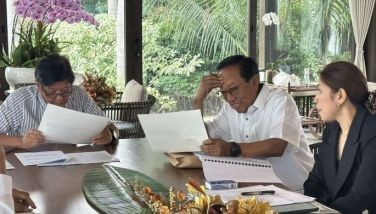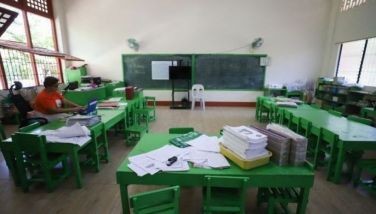Creation of regional central banks
February 10, 2003 | 12:00am
In order for a country to fully develop, it is requisite sine qua non that its banking system be properly structured. Banks play a critical role in a free enterprise economy. The banking sector provides the wherewithal to finance business transactions. The banks lend the money needed by the entrepreneurs and businessmen to rev the economy and expand production. The banks direct the flow of money to the priority areas of development. Hence, when a country does not have a good financial structure as crystallized in its banking system, it can never develop properly and optimally.
At the apex of the banking system is the Central Bank. The Bangko Sentral Ng Pilipinas (BSP) is the central bank of the Philippines. It was established as an independent central monetary authority pursuant to the Constitution and the New Central Bank Act of 1993 as part of the restructuring of the old Central Bank of the Philippines, which was originally established in 1949. The capital of the BSP is P50 billion of which only P10 billion has been fully paid for by the government.
This writer submits that there is an imperative need to strengthen the Central Bank by restructuring it in such a way that there shall be a Central Bank for each of the regions of the country.
Presently, a single Central Bank based in Metro Manila provides all the central banking needs of the country, that is, from Batanes to Sulu. With only P10 billion in present capital, this lone Central Bank is stretched to its limits as its resources is obviously inadequate to finance all the development needs of the entire country. The result? Only a small part of the country, the few metropolitan areas and cities, have the money to be developed while the rest of the country, the vast countryside from Luzon, Visayas and Mindanao, remain backward and undeveloped to this day. Like a weak heart of an anemic person that can only pump droplets of blood to the body, the patient remains unhealthy as his low supply of blood cannot meet the entire body’s demand for it to keep him healthy. The same principle works for the economy. If the Central Bank, the heart of the system, is not pumping into the economy the proper and adequate amount of money, then only a few areas to which the money supply is directed shall be developed, leaving the rest depressed and impoverished.
The obvious solution, then, is to see to it that all parts of the country are properly and adequately supplied with the money corresponding to their respective need for them to develop. It is here that a Central Bank can play a pivotal and critical role if only its presence is felt all over the country. Hence, there is an urgent need to establish a Central Bank for each of the 13 regions of the country. These regional Central Banks shall be tasked to provide the commensurate money supply consistent with all the development needs of its particular area of jurisdiction. Particularly, each regional Central Bank shall be mandated to buy the 30-year long-term, low-interest bonds, that shall be floated by the local government units concerned, by creating the new money to be infused into the economy of each region and which new money shall then be channeled for the full development of each place. The revenues collected by each region in the form of transaction taxes from the newly-created money will then be used to eventually retire the local government bonds.
This course of action must be considered by our responsible authorities as the only viable alternative given the fact and reality that government cannot expect to build the infrastructure and set-up the utilities from taxes alone as, being a still developing country, we do not have a sufficient tax base to fully support our development needs through present taxes alone. Hence, we shall keep on repeating and stressing that all the present monetary needs for infrastructure and utilities of all the regions of the country should be financed with newly-created local money which shall be securitized against future taxes.
To be sure, this concept of regionalization of Central Banks is not a novel idea. In fact, it is a tried and tested formula adopted with tremendous success by no less than the mightiest economy of the world – the United States of America. Before 1912, the United States was not developed as yet and was an economically struggling country much as we are now. The Federal Reserve Act of 1912 changed all that. The law created 13 independent Federal Banks spread across the country that took charge of funding and developing the areas under each bank’s jurisdiction so that every part of the country was equally attended to. The result? A vibrant and progressive America fully developed in all its 50 States that is the envy of the world.
We must follow this lead and ourselves legislate into existence these regional Central Banks that can jumpstart the total development of each region independent of financial support from the national government based in Manila. The core idea is to have the regional Central Banks closer to the economic players and the market and, thus, be in a much better position to determine the precise level of money of supply, neither over-supplied nor under-supplied, that should be released into each region. This way, each local government unit can float the exact amount of long-term, low-interest bonds that each regional Central Bank shall buy by creating corresponding new-local money that will be channeled into the region’s economic system for its development. Again, the revenues collected by each local government in the form of transaction taxes from the newly-created local money will be used to eventually retire the bonds.
By this approach, long-term, low-interest credit facilities can be made available to the local businessmen for them to grow big and be as competitive as their foreign counterparts. With adequate money at hand, all the land in each region can be developed, all the roads, ports, airports, school, markets, hospitals and communication facilities built, and all our infrastructure and utilities put in place.
Government must not fear incurring budget-deficits on account of the creation of new money through the floatation of government bonds. For really the notion that "if there is a deficit, it is bad" is misplaced. On the contrary, we must invest for the future now by developing all our infrastructure and utilities today by financing them through borrowings against future taxes. Indeed, we must not be alarmed by a budget deficit but must rather incur them now by floating long-term bonds of at least 30 years so there will be sufficient time to generate the taxes to pay the bonds. As death and taxes are certain, there is no cause for worry when a budget deficit is incurred due to government investments through the issuance of bonds.
As a matter of fact, the total obligation of the United States is $13.5 trillion as of 2001 broken down into $5 trillion as State obligations and $8.5 trillion as Federal obligations. This $13.5-trillion obligation of America is actually its borrowings against future taxes. Despite this gargantuan deficit, the US is not worried because it has a vibrant economy that is capable of paying-off its obligations by way of future tax collections.
We must then do the same for the Philippines, and develop the entire country now.
(You may write your comments/suggestions at 15/F Equitable Bank Tower Paseo de Roxas, Makati City or through e-mail at [email protected])
(Editor’s note: Atty. Roxas is writing a limited series of articles dealing with financial matters and other important business topics. – Ed.)
At the apex of the banking system is the Central Bank. The Bangko Sentral Ng Pilipinas (BSP) is the central bank of the Philippines. It was established as an independent central monetary authority pursuant to the Constitution and the New Central Bank Act of 1993 as part of the restructuring of the old Central Bank of the Philippines, which was originally established in 1949. The capital of the BSP is P50 billion of which only P10 billion has been fully paid for by the government.
This writer submits that there is an imperative need to strengthen the Central Bank by restructuring it in such a way that there shall be a Central Bank for each of the regions of the country.
Presently, a single Central Bank based in Metro Manila provides all the central banking needs of the country, that is, from Batanes to Sulu. With only P10 billion in present capital, this lone Central Bank is stretched to its limits as its resources is obviously inadequate to finance all the development needs of the entire country. The result? Only a small part of the country, the few metropolitan areas and cities, have the money to be developed while the rest of the country, the vast countryside from Luzon, Visayas and Mindanao, remain backward and undeveloped to this day. Like a weak heart of an anemic person that can only pump droplets of blood to the body, the patient remains unhealthy as his low supply of blood cannot meet the entire body’s demand for it to keep him healthy. The same principle works for the economy. If the Central Bank, the heart of the system, is not pumping into the economy the proper and adequate amount of money, then only a few areas to which the money supply is directed shall be developed, leaving the rest depressed and impoverished.
The obvious solution, then, is to see to it that all parts of the country are properly and adequately supplied with the money corresponding to their respective need for them to develop. It is here that a Central Bank can play a pivotal and critical role if only its presence is felt all over the country. Hence, there is an urgent need to establish a Central Bank for each of the 13 regions of the country. These regional Central Banks shall be tasked to provide the commensurate money supply consistent with all the development needs of its particular area of jurisdiction. Particularly, each regional Central Bank shall be mandated to buy the 30-year long-term, low-interest bonds, that shall be floated by the local government units concerned, by creating the new money to be infused into the economy of each region and which new money shall then be channeled for the full development of each place. The revenues collected by each region in the form of transaction taxes from the newly-created money will then be used to eventually retire the local government bonds.
This course of action must be considered by our responsible authorities as the only viable alternative given the fact and reality that government cannot expect to build the infrastructure and set-up the utilities from taxes alone as, being a still developing country, we do not have a sufficient tax base to fully support our development needs through present taxes alone. Hence, we shall keep on repeating and stressing that all the present monetary needs for infrastructure and utilities of all the regions of the country should be financed with newly-created local money which shall be securitized against future taxes.
To be sure, this concept of regionalization of Central Banks is not a novel idea. In fact, it is a tried and tested formula adopted with tremendous success by no less than the mightiest economy of the world – the United States of America. Before 1912, the United States was not developed as yet and was an economically struggling country much as we are now. The Federal Reserve Act of 1912 changed all that. The law created 13 independent Federal Banks spread across the country that took charge of funding and developing the areas under each bank’s jurisdiction so that every part of the country was equally attended to. The result? A vibrant and progressive America fully developed in all its 50 States that is the envy of the world.
We must follow this lead and ourselves legislate into existence these regional Central Banks that can jumpstart the total development of each region independent of financial support from the national government based in Manila. The core idea is to have the regional Central Banks closer to the economic players and the market and, thus, be in a much better position to determine the precise level of money of supply, neither over-supplied nor under-supplied, that should be released into each region. This way, each local government unit can float the exact amount of long-term, low-interest bonds that each regional Central Bank shall buy by creating corresponding new-local money that will be channeled into the region’s economic system for its development. Again, the revenues collected by each local government in the form of transaction taxes from the newly-created local money will be used to eventually retire the bonds.
By this approach, long-term, low-interest credit facilities can be made available to the local businessmen for them to grow big and be as competitive as their foreign counterparts. With adequate money at hand, all the land in each region can be developed, all the roads, ports, airports, school, markets, hospitals and communication facilities built, and all our infrastructure and utilities put in place.
Government must not fear incurring budget-deficits on account of the creation of new money through the floatation of government bonds. For really the notion that "if there is a deficit, it is bad" is misplaced. On the contrary, we must invest for the future now by developing all our infrastructure and utilities today by financing them through borrowings against future taxes. Indeed, we must not be alarmed by a budget deficit but must rather incur them now by floating long-term bonds of at least 30 years so there will be sufficient time to generate the taxes to pay the bonds. As death and taxes are certain, there is no cause for worry when a budget deficit is incurred due to government investments through the issuance of bonds.
As a matter of fact, the total obligation of the United States is $13.5 trillion as of 2001 broken down into $5 trillion as State obligations and $8.5 trillion as Federal obligations. This $13.5-trillion obligation of America is actually its borrowings against future taxes. Despite this gargantuan deficit, the US is not worried because it has a vibrant economy that is capable of paying-off its obligations by way of future tax collections.
We must then do the same for the Philippines, and develop the entire country now.
(You may write your comments/suggestions at 15/F Equitable Bank Tower Paseo de Roxas, Makati City or through e-mail at [email protected])
(Editor’s note: Atty. Roxas is writing a limited series of articles dealing with financial matters and other important business topics. – Ed.)
BrandSpace Articles
<
>
- Latest
- Trending
Trending
Latest
Trending
Latest
Recommended






























